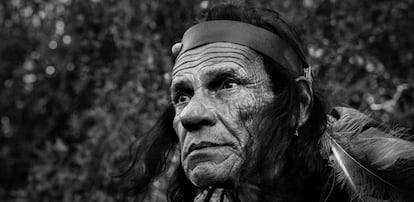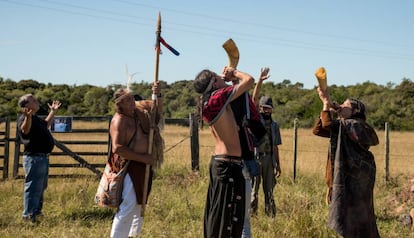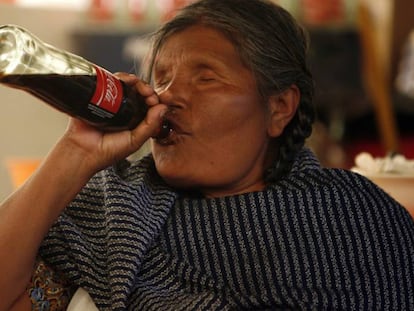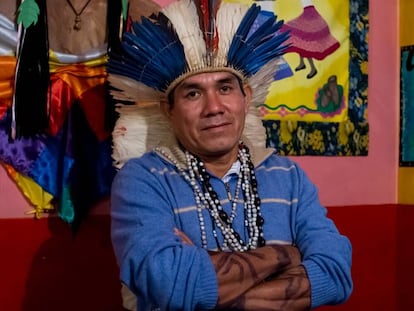Where did Uruguay¡¯s indigenous population go?
The Latin American country is being confronted with its past and asked to recognize the Charr¨²a people


Having survived 300 years of colonization and a planned massacre in Uruguay, members of the Charr¨²a indigenous tribe are resurfacing to demand recognition from a country whose foundations were built on the graves of their ancestors.
It is generally believed that Uruguay is populated exclusively by the descendants of the settlers, who were predominantly Spanish and Italian, but recent genetic studies have discredited this theory. Now around 2,000 people belonging to an ethnic group whose identity has long been denied have joined a movement that calls for issues of genocide and discrimination to be finally addressed.
Around 2,000 people have joined a movement that calls for issues of genocide to be finally addressed
In Uruguay, to talk of the Charr¨²a has always been to talk of the past. According to the official version of events, they died out in 1831. What survived of this proud race with their high cheekbones was little more than expressions such as ¡°Charr¨²a stamina,¡± often used in a sporting context to refer to tenacity ¨C a character trait that has undoubtedly led this ethnic group to embark on a process of ¡°ethnogenesis.¡±
Ethnogenesis is the reconfiguration and re-emergence of different ethnic groups due to external factors. In the case of the Charr¨²a people, the violent creation of Uruguay led them to shed their identity and merge with the general population to avoid discrimination. However, recent social and political changes, combined with international recognition and the urge to belong, have driven the Charr¨²a to reclaim their identity and heritage.
According to M¨®nica Michelena D¨ªaz, a consultant for indigenous concerns at the Ministry of Foreign Affairs¡¯ Ethnic Racial Unit, the process of self-discovery began in 1985, just after Uruguay¡¯s military dictatorship came to an end. Taking advantage of a more liberal climate, a play about the notorious Salsipuedes massacre was produced, and this subsequently prompted demand for acknowledgement, both past and present.
¡°It was a very important production for us, because it questioned the origins of the State of Uruguay,¡± says M¨®nica, who discovered her Charr¨²a roots when she was 19. Seeking answers to the questions thrown up by the play, she went on to establish the Council of the Charr¨²a Nation (CONACHA) in 2005.

CONACHA is now an umbrella organization for 10 Charr¨²a collectives across the country. One of its main objectives is to obtain recognition from the Uruguayan State as an ethnic group, and another is to get the state to ratify the International Labor Organization¡¯s Indigenous and Tribal Peoples Convention (No. 169). CONACHA is also encouraging people to claim their indigenous heritage while calling for the massacre at Salsipuedes to be recognized as genocide. ¡°Our ancestors lost their lives in an ambush organized by the state,¡± says M¨®nica.
Uruguay and the Guianas are the only countries in Latin America that have not ratified the ILO Convention No. 169. ¡°In 2015, I was in Bilbao on a UN grant,¡± says M¨®nica. ¡°I found out that President Mujica would be with [Luis] Almagro [Uruguay¡¯s Minister of Foreign Affairs] at the Consulate, so I got all the documents together asking for the ratification of the convention.¡±
The documents were duly handed over to the two men and on their return home, they held meetings with the Ministry of Employment and Social Security. But the conclusion they reached was unsatisfactory to say the least. ¡°We were told to lower our expectations and ask that only a few of the articles of the convention be ratified,¡± she says. The convention, however, does not allow for a piecemeal, making this option nonviable.
Our ancestors lost their lives in an ambush organized by the state M¨®nica Michelena D¨ªaz, a consultant for indigenous concerns
With the change of government that year, CONACHA tried again. But the then-Vice President Ra¨²l Sendic told them that his government would not ratify it, either.
In an interview with the Uruguayan radio station Radio Pedal, Mart¨ªn Delgado Cultelli, one of the directors of CONACHA, said there were two reasons the government refuses to ratify the convention. One ¨C ¡°because of the country¡¯s history, which was built on a genocide designed to make indigenous tribes invisible,¡± and also ¡°because of pressure applied by the rural trade guilds¡± in connection with the return of land.
According to Uruguay¡¯s National Statistics Institute the first survey to inquire about ethnic origins wasn¡¯t carried out in Uruguay until 1996. At that time just 0.4% of respondents identified themselves as indigenous, a figure that rose to 2.9% in 2006. In the most recent survey carried out in 2011, 5% of respondents said they identified themselves as indigenous. But even this figure has little to do with the data produced by recent research carried out by M¨®nica Sans, Professor in Biological Anthropology at Uruguay¡¯s University of the Republic, and which has shaken the foundations of the country¡¯s collective identity.
Sans and her team have focused on mitochondrial DNA sequences. As the mitochondria are inherited from the mother, they serve as a basis for tracing descent through the female line. ¡°The national percentage descending [from indigenous tribes] on the mother¡¯s side is around 34% ¨C in other words, approximately a third of the population,¡± says Sans. ¡°The highest percentages are found in the north, in the Tacuaremb¨® region and areas such as Bella Uni¨®n, where it is about 64%.¡±
In the most recent survey carried out in 2011, 5% of respondents said they belonged to an indigenous ethnic group
Sans goes on to explain that the matter of who belongs to which particular indigenous group is still to be determined. ¡°In the case of Bella Uni¨®n, there are DNA sequences from Amazonian ethnic groups such as the Guaran¨ª, and also from ¡®P¨¢mpidos¡¯ ¨C the generic name for ethnic groups which include the Charr¨²a.¡±
Asked how she thinks her findings will impact on the country¡¯s national identity, Sans says that the mood is changing and that ethnic issues are already being presented in schools by anthropology students. ¡°It¡¯s also being dealt with by social anthropologists and collectives who are moving this on a national level,¡± she says.
CONACHA is also introducing the issue into education through the recently created Intercultural Charr¨²a Itinerant School. Financed by the Social Development Ministry, the school has already been active in areas of the capital, Montevideo, and is now preparing to travel into the country¡¯s interior to extend its reach.

Genocide?
The UN Convention on the Prevention and Punishment of the Crime of Genocide defines genocide as ¡°any of the following acts committed with intent to destroy, in whole or in part, a national, ethnic, racial or religious group, as such;¡± including the slaughter of members of a group or serious assault against the psychological or physical well-being of it members.
On April 24, during an open session of Parliament, a young woman asked President Tabar¨¦ V¨¢zquez to declare his position on the genocide of the Charr¨²a. The president answered that he understood the desire for acknowledgment but said that genocide is a term to be used with care. ¡°It has to be demonstrated that the intention was to wipe out a race or a particular group of people,¡± he said, adding that his position on the matter was still under consideration and that the government was studying it with ¡°scientific rigor¡±.
There was a specific intention to kill a particular indigenous group. In this case, we can talk about genocide and ethnocide M¨®nica Sans, professor of biological anthropology
The term Charr¨²a genocide does, however, appear in the elementary school curriculum as one of the subjects to be taught in fifth-grade history class, alongside the country¡¯s first presidents. The word also found its way into the House of Representatives last July, when a left-wing politician from the Frente Amplio party, Stella Viel, asked that the genocide be acknowledged. Meanwhile, M¨®nica Sans is categorical on the subject. ¡°Yes, I think it was genocide,¡± she says. ¡°There was a specific intention to kill a particular indigenous group. In this case, we can talk about genocide and ethnocide.¡±
Meanwhile, every year a number of Charr¨²a descendants congregate in Salsipuedes to commemorate the past. They call it ¡°a place of reunion¡±. On the journey there, they tell anecdotes about the ¡°indomitable character¡± of their ancestors who died in a cruel ambush that was meant to eliminate them, but failed.
English version by Heather Galloway.
Tu suscripci¨®n se est¨¢ usando en otro dispositivo
?Quieres a?adir otro usuario a tu suscripci¨®n?
Si contin¨²as leyendo en este dispositivo, no se podr¨¢ leer en el otro.
FlechaTu suscripci¨®n se est¨¢ usando en otro dispositivo y solo puedes acceder a EL PA?S desde un dispositivo a la vez.
Si quieres compartir tu cuenta, cambia tu suscripci¨®n a la modalidad Premium, as¨ª podr¨¢s a?adir otro usuario. Cada uno acceder¨¢ con su propia cuenta de email, lo que os permitir¨¢ personalizar vuestra experiencia en EL PA?S.
?Tienes una suscripci¨®n de empresa? Accede aqu¨ª para contratar m¨¢s cuentas.
En el caso de no saber qui¨¦n est¨¢ usando tu cuenta, te recomendamos cambiar tu contrase?a aqu¨ª.
Si decides continuar compartiendo tu cuenta, este mensaje se mostrar¨¢ en tu dispositivo y en el de la otra persona que est¨¢ usando tu cuenta de forma indefinida, afectando a tu experiencia de lectura. Puedes consultar aqu¨ª los t¨¦rminos y condiciones de la suscripci¨®n digital.
More information










































